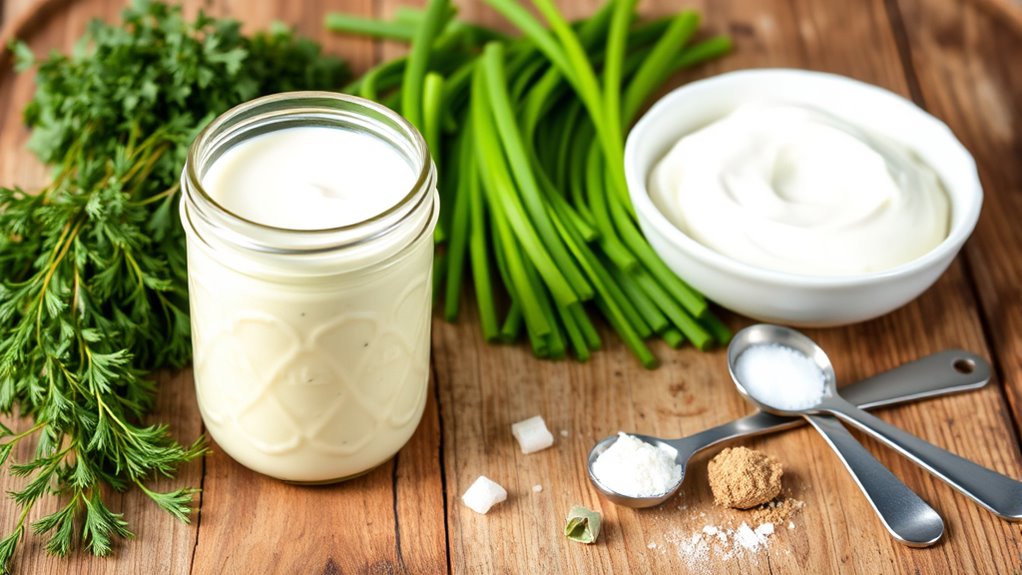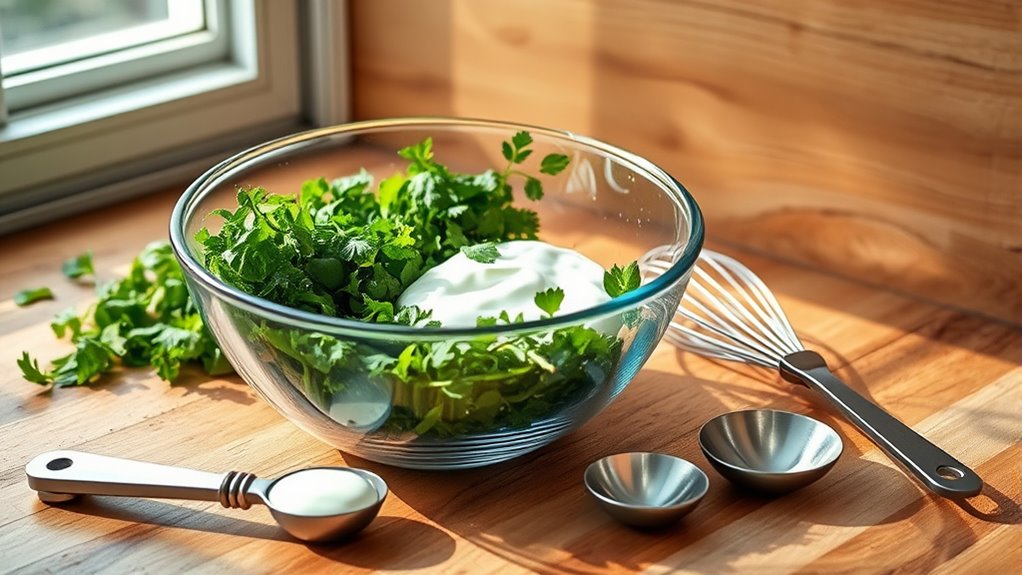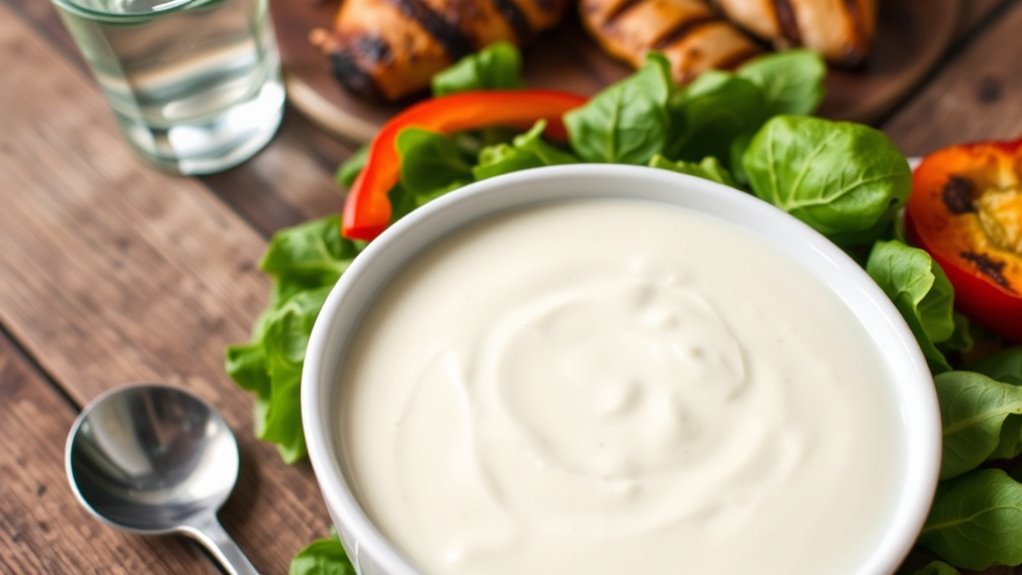This low-sodium ranch dressing keeps you tasting the flavor without excess salt. In a bowl, whisk ¾ cup yogurt, ¼ cup buttermilk (or dairy-free), 2 tbsp light mayo, and 2 tbsp lemon juice or white vinegar until smooth. Add 1 tsp dried dill, ½ tsp garlic powder, ½ tsp onion powder, ¼ tsp black pepper, and ¼ tsp salt substitute, then adjust with water to reach pourable consistency. Let it rest 10 minutes for best flavor, and you’ll uncover more tweaks and tips ahead.
Ingredients and Quantity

For this low-sodium ranch salad dressing, gather the following ingredients and quantities: ¾ cup plain yogurt (low-fat or nonfat), ¼ cup buttermilk or dairy-free alternative, 2 tablespoons light mayo, 2 tablespoons lemon juice or white vinegar, 1 teaspoon dried dill, ½ teaspoon garlic powder, ½ teaspoon onion powder, ¼ teaspoon black pepper, and ¼ teaspoon salt substitute or to taste. This list foregrounds Low Sodium and Flavor Enhancement by choosing low-sodium bases with balanced acids. Use precise quantities to guarantee consistency and repeatable results.
| Ingredient | Amount | Purpose |
|---|---|---|
| Yogurt | ¾ cup | Creamy base |
| Liquid | ¼ cup | Smoothness |
| Spices | ½ tsp–1 tsp | Flavor depth |
Preparations

To prep the dressing, combine the yogurt, buttermilk, and light mayo in a small bowl and whisk until smooth. You’ll then assess texture and adjust with a splash of water or milk to reach a pourable consistency. Prepping ingredients efficiently means measuring salt alternatives and seasonings beforehand, so you can add them in a controlled, repeatable way. For mixing techniques, fold in herbs, garlic powder, and onion powder gradually, avoiding overmixing to prevent slight curdling. Afterward, let the dressing rest briefly for flavor integration, then recheck thickness and seasoning. Document exact quantities you used so future batches are consistent. This approach emphasizes repeatable steps, clear measurements, and a practical workflow that respects your desire for culinary autonomy and reliable results.
Kitchen tools or Kitchenware Required

A few essential tools keep this low-sodium ranch dressing flow smooth: a mixing bowl (preferably medium-size), a whisk or a small hand mixer for smooth emulsification, and a measuring set (cups and spoons) to guarantee repeatable salt-alternative quantities. You’ll rely on mixing bowls for base, and measuring spoons for precise salt substitutes, ensuring consistent flavor with every batch. Practicality matters: choose tools easy to clean and store, minimizing cleanup time. The following table adds clarity about tool roles and outcomes:
| Tool | Purpose | Benefit |
|---|---|---|
| Mixing bowls | Base prep | Even emulsification |
| Whisk / hand mixer | Emulsification | Smooth texture |
| Measuring spoons | Precision | Repeatable ratios |
How to Cook

- Whisk together the core ingredients in a medium bowl.
- Gradually whisk in the dairy or dairy-free base until you reach a smooth, creamy consistency.
- Monitor texture as you go, stopping once the dressing coats a spoon without dripping in thin ribbons.
- Let the dressing rest for 10 minutes to hydrate spices and emulsifiers for best flavor.
- Re-stir briefly after resting.
- Taste and adjust salt, pepper, and acidity with small additions.
- Use this method to achieve reliable results across batch sizes, allowing you to scale up for gatherings.
- Consider salad variations to match different greens or proteins.
- Explore dressing alternatives like yogurt, kefir, or mayo-free bases if needed.
- Follow these repeatable, evidence-based steps to gain control, consistency, and confidence.
How to Serve

Serving tips for Low Sodium Ranch Salad Dressing focus the sauce on ready-to-use portions and complementary greens. You pour modest portions to control sodium intake while maintaining flavor balance, then pair with crisp romaine, mixed greens, or baby spinach for texture. For serving suggestions, drizzle over salads just before serving to preserve coating evenness and avoid sogginess. Consider a chilled bowl and a small ladle to guarantee consistent portions. Pairing options include grilled chicken, turkey, or chickpeas for lean protein, plus crunchy vegetables like cucumbers or bell peppers to enhance mouthfeel. This approach supports portion control without sacrificing satisfaction. Remember to store any leftovers in a labeled container and refrigerate promptly, reinforcing practical, evidence-based habits for flavorful, low-sodium dining.
Tips
Wondering how to maximize flavor without boosting sodium? Start with small, precise tweaks you can trust. Use herbs and spices to build character before adding salt alternatives, then taste and adjust in stages. Healthy substitutions matter: swap in sodium‑free ranch mix or cultured dairy accents (yogurt, buttermilk) to deepen texture without excess sodium. Flavor enhancements come from acid balance—lemon juice, a splash of vinegar, or a pinch of mustard can brighten every note without overpowering the profile. Enhance mouthfeel with a touch of emulsified olive oil or tahini, which also helps carry flavors. Build layers by adding crushed garlic, onion powder, and fresh chives at the end. Keep a running taste test, and document what works for your palate.
Food Value and Benefit
This dressing adds significant nutritional value to your diet by combining rich flavor with essential nutrients. It contains vitamins such as Vitamin E and Vitamin K, which support antioxidant protection and bone health, along with minerals like magnesium and potassium that help regulate blood pressure and muscle function. The balanced sodium content ensures it supports cardiovascular health without excess intake. Healthy fats in the dressing promote satiety and enhance the absorption of fat-soluble vitamins from your meals.
This dressing blends flavor with Vitamin E, K, magnesium, and potassium to support heart health and nutrient absorption.
Benefits of eating this dressing include:
- Supports heart health with a low-sodium, hydration-friendly profile
- Provides healthy fats that aid fullness and improve nutrient absorption
- Supplies antioxidants through Vitamin E for cell protection
- Contains Vitamin K for improved bone strength and blood clotting
- Includes essential minerals like magnesium and potassium for muscle and nerve function
- Versatile and easy to use, enhancing nutrient-dense meals like salads, grains, and bowls
- Helps sustain energy levels during training or busy days without adding excess calories
Enjoy a flavorful, guilt-free addition to your balanced diet that promotes overall wellness and simplicity in healthy eating.
Frequently Asked Questions
Can I Substitute Dairy-Free Yogurt in This Dressing?
Yes, you can substitute dairy-free yogurt. Use dairy free alternatives with similar yogurt consistency, preferably unsweetened, and adjust acidity with a splash of lemon. Start with a 1:1 swap and taste, then tweak for creaminess.
How Long Can the Dressing Be Stored Refrigerated?
Storage duration for this dressing in the fridge is about 1 week. Think of it like a well-ted jar: you’ll notice Dressing freshness waning after day 7, so use it sooner and keep conditions ultra-cold.
Is a Blender or Whisk Better for Emulsification?
A blender typically offers better blender efficiency for emulsification, but a whisk can achieve excellent results with proper whisk technique. Choose based on texture you want and your equipment, prioritizing steady, controlled mixing for consistent emulsions.
Can I Double the Recipe for a Larger Crowd?
Yes, you can double the recipe for a larger crowd. Doubling ingredients works best with extra whisking or blending to maintain emulsion. Serving suggestions: chill well, offer with veggies or chips, and label portions for easy self-serve.
Are There Gluten-Free Thickening Options?
Yes, you can, and you’ll want gluten free flours or other thickening agents. Use small amounts, whisk well, and test. Start with 1–2 teaspoons, adjust for desired consistency, prioritizing gluten free flours and reliable thickening agents.
